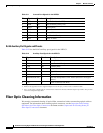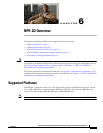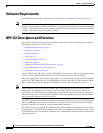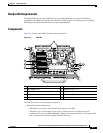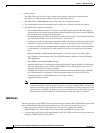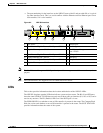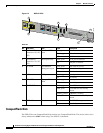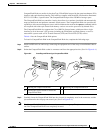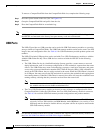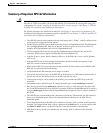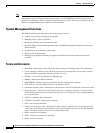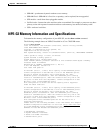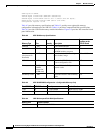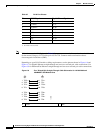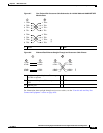
6-8
Network Processing Engine and Network Services Engine Installation and Configuration
OL-4448-12
Chapter 6 NPE-G2 Overview
NPE-G2 Description and Overview
To remove a CompactFlash Disk from the CompactFlash Disk slot, complete the following steps:
Step 1 Press the ejector button on the slot. (See 3 in Figure 6-4.)
Step 2 Grasp the CompactFlash Disk and pull it from the slot.
Step 3 Place the CompactFlash Disk in an antistatic bag.
Note All CompactFlash Disks must be formatted before their initial use. CompactFlash Disks shipped with
the NPE-G2 are formatted at the factory, but spare memory cards are not formatted.
USB Ports
The NPE-G2 provides two USB ports that can be used with USB Flash memory modules as secondary
storage, similar to CompactFlash Disks. The USB Flash memory modules can be used to store Cisco IOS
images, data, and configuration files. See
Table 6-5 for USB Flash memory module product options and
numbers.
The NPE-G2 includes USB ports that can be used with Cisco USB Flash memory modules or with the
Aladdin USB eToken Pro key. These USB devices can be used with the NPE-G2 for the following
functions:
• The USB eToken Pro key by Aladdin Knowledge Systems provides a secure means to store and
deploy information, such as a bootstrap configuration or VPN credentials, separate from the router
chassis. The USB eToken uses smart card technology to protect a small area of memory and grants
access using a personal identification number (PIN). When IP Security (IPSec) VPN credentials are
stored on the USB eToken, they are safely external to the router. When the USB eToken is inserted
in a USB port, the router can pass the PIN and unlock it, retrieving the credentials and copying them
into running memory. When the USB eToken is removed, the router will erase the credentials from
running memory, ensuring that they cannot be retrieved from the router itself.
Note For more information about the USB eToken Pro key by Aladdin Knowledge Systems, see
the Aladdin website at www.aladdin.com/etoken/cisco.
• The Cisco USB Flash memory module can be used to store an image or configuration file like a
CompactFlash Disk. Unlike the USB eToken, the Cisco USB Flash memory module is nonsecure.
See
Table 6-5 for available USB Flash memory module configurations and product numbers.
Note The Cisco USB Flash memory module cannot be used to boot the router. The USB drivers
exist only in Cisco IOS software, not ROM Monitor mode (ROMmon). As a result, a Cisco
IOS image must be booted to load the drivers; only then can files be copied to and from the
USB Flash memory module.
Note For detailed information about the Cisco IOS commands that support USB Flash memory modules, see
the Cisco IOS USB Flash Module and USB eToken Support document.



